Related Research Articles

Elihu Yale was a British-American colonial administrator and philanthropist. Born in Boston, Massachusetts, Yale only lived in America as a child, spending the rest of his life in England, Wales, and India. He became a clerk for the East India Company at Fort St. George, and eventually rose to the Presidency of the settlement. He was later removed from the post under charges of corruption for self-dealing and required to pay a fine. In 1699 he returned to Britain with a considerable fortune, around £200,000, mostly made by selling diamonds, and spent his time and wealth in philanthropy and art collecting. He is best remembered as the primary benefactor of Yale College, which was named in his honor, following a donation of books, portrait, and textiles under the request of Rev. Cotton Mather, a Harvard graduate. He had no male heir, and no descendants of his have survived past his grandchildren.

Jewellery consists of decorative items worn for personal adornment, such as brooches, rings, necklaces, earrings, pendants, bracelets, and cufflinks. Jewellery may be attached to the body or the clothes. From a western perspective, the term is restricted to durable ornaments, excluding flowers for example. For many centuries metal such as gold often combined with gemstones, has been the normal material for jewellery, but other materials such as glass, shells and other plant materials may be used.

A brooch is a decorative jewellery item designed to be attached to garments, often to fasten them together. It is usually made of metal, often silver or gold or some other material. Brooches are frequently decorated with enamel or with gemstones and may be solely for ornament or serve a practical function as a clothes fastener. The earliest known brooches are from the Bronze Age. As fashions in brooches changed rather quickly, they are important chronological indicators. In archaeology, ancient European brooches are usually referred to by the Latin term fibula.

A parure is a set of various items of matching jewelry, which rose to popularity in early 19th-century Europe.
Sir John Boardman, is a classical archaeologist and art historian. He has been described as "Britain's most distinguished historian of ancient Greek art."
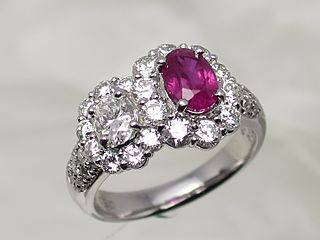
A ring is a round band, usually made of metal, worn as ornamental jewelry. The term "ring" by itself denotes jewellery worn on the finger; when worn as an ornament elsewhere, the body part is specified within the term, e.g., earrings, neck rings, arm rings, and toe rings. Rings fit snugly around or in the part of the body they ornament, so bands worn loosely, like a bracelet, are not rings. Rings may be made of almost any hard material: wood, bone, stone, metal, glass, jade, gemstone or plastic. They may be set with gemstones or with other types of stone or glass.
Micromosaics are a special form of mosaic that uses unusually small mosaic pieces (tesserae) of glass, or in later Italian pieces an enamel-like material, to make small figurative images. Surviving ancient Roman mosaics include some very finely worked panels using very small tesserae, especially from Pompeii, but only from Byzantine art are there mosaic icons in micromosaic with tesserae as small as the best from the Modern period. Byzantine examples, which are very rare, were religious icons. They are usually framed and treated like portable paintings.
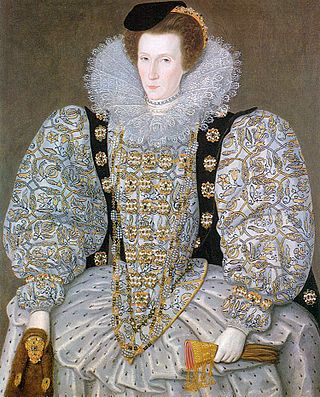
A zibellino, flea-fur or fur tippet is a women's fashion accessory popular in the later 15th and 16th centuries. A zibellino, from the Italian word for "sable", is the pelt of a sable or marten worn draped at the neck or hanging at the waist, or carried in the hand. The plural is zibellini. Some zibellini were fitted with faces and paws of goldsmith's work with jeweled eyes and pearl earrings, while unadorned furs were also fashionable.
Sir John Spilman was a Lindau, German-born entrepreneur who founded the first commercially successful paper-mill in England, establishing a factory on the River Darenth in Dartford, Kent in 1588. Spilman was also jeweller to Queen Elizabeth I, and was knighted by King James I.

The "Marlborough gem" is a carved onyx cameo that depicts an initiation ceremony of Psyche and Eros. It is the most famous engraved gem in the extensive and prominent collection both inherited and expanded by George Spencer, 4th Duke of Marlborough. Since 1899 it has been in the collection of the Boston Museum of Fine Arts, where it is described as a "cameo with the wedding of Cupid and Psyche, or an initiation rite", reflecting the view of its subject generally held until the last century.
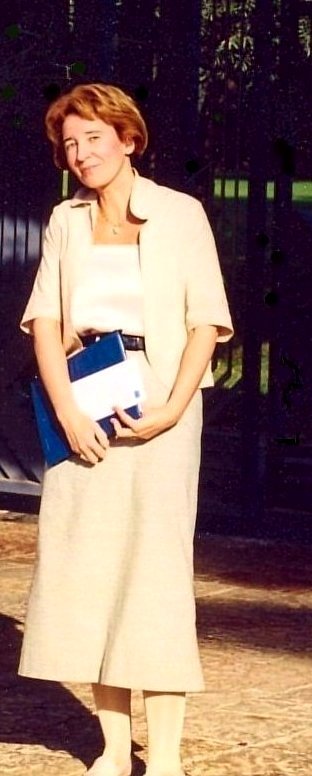
Joanna Angelett is the artist name of Joanna Trummer, a British-Australian jewellery designer, author, founder of the worldwide anti-racism Tree of Life art project. As a designer she is best known for her sculpture-like jewellery, and as creator of desktop items of precious metals, decorated with gems and cloisonné enamels.
Costume and gold and silver plate belonging to Elizabeth I were recorded in several inventories, and other documents including rolls of New Year's Day gifts. Arthur Jefferies Collins published the Jewels and Plate of Queen Elizabeth I: The Inventory of 1574 from manuscripts in 1955. The published inventory describes jewels and silver-plate belonging to Elizabeth with detailed references to other source material. Two inventories of Elizabeth's costume and some of her jewellery were published by Janet Arnold in Queen Elizabeth's Wardrobe Unlocke'd.
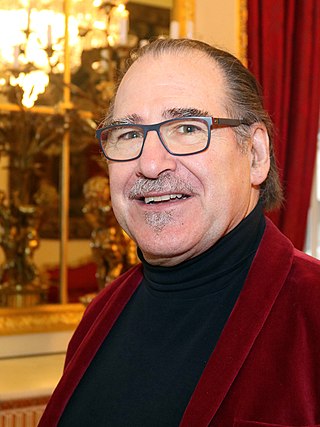
Jack Ogden, FSA, FGA, is a British jewellery historian with a particular interest in the development of Materials and technology. He is considered one of the foremost experts in his field. He is the current President of The Society of Jewellery Historians, having held the position since February 2018, and was appointed visiting professor of Ancient Jewellery, Material and Technology, at the Birmingham School of Jewellery Birmingham City University in 2019

The Chequers Ring is one of the few surviving pieces of jewellery worn by Queen Elizabeth I of England. The mother-of-pearl ring, set with gold and rubies, includes a locket with two portraits, one depicting Elizabeth and the other traditionally identified as Elizabeth's mother Anne Boleyn, but possibly her step-mother Catherine Parr. The ring is presently housed at Chequers, the country house of the prime minister of the United Kingdom.
Anne Livingstone, Countess of Eglinton was a Scottish courtier and aristocrat, and lady-in-waiting to Princess Elizabeth and Anne of Denmark.

Nicasius Roussel, Nicasius Rousseel or Nicasius Russell was a Flemish goldsmith, jewelry merchant, draftsman, engraver (printmaker) and court artist who worked in London for James I, Anne of Denmark, and Charles I. He became a naturalized citizen of England in 1608.
Arnold Lulls was a Flemish goldsmith and jeweller in London. He served the court and made several pieces intended as diplomatic gifts.
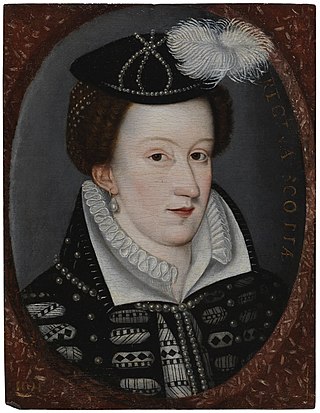
The jewels of Mary, Queen of Scots (1542–1587), are mainly known through the evidence of inventories held by the National Records of Scotland. She was bought jewels during her childhood in France, adding to those she inherited. She gave gifts of jewels to her friends and to reward diplomats. When she abdicated and went to England many of the jewels she left behind in Scotland were sold or pledged for loans, first by her enemies and later by her allies. Mary continued to buy new jewels, some from France, and use them to reward her supporters. In Scotland her remaining jewels were worn by her son James VI and his favourites.

The jewels of Anne of Denmark (1574–1619), wife of James VI and I and queen consort of Scotland and England, are known from accounts and inventories, and their depiction in portraits by artists including Paul van Somer. A few pieces survive. Some modern historians prefer the name "Anna" to "Anne", following the spelling of numerous examples of her signature.

An inventory of the jewels of Mary I of England, known as Princess Mary or the Lady Mary in the years 1542 to 1546, was kept by her lady in waiting Mary Finch. The manuscript is now held by the British Library. It was published by Frederic Madden in 1831. Some pieces are listed twice. Two surviving drawings feature a ribbon with the inscription, "MI LADI PRINSIS". The British Library also has an inventory of the jewels she inherited on coming to the throne in 1553.
References
- ↑ Carla van de Puttelaar, 'Diana Scarisbrick', National Portrait Gallery
- ↑ Carla van de Puttelaar: Female Voices in Art: Diana Scarisbrick, Jewellery Historian
- ↑ Sarah Laurenson, The Material Landscapes of Scotland's Jewellery Craft, 1780–1914 (Bloomsbury, 2023), p. 134.
- ↑ Kathrin Lassila, 'Elihu Yale, nabob', Yale Alumni Magazine, March/April, 2014